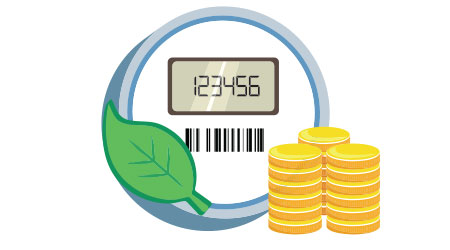Electric Tariffs Expand Metering Opportunities
Once you understand how a facility's power is priced, you can start taking steps to reducing cost.
Electric rates are determined through regulatory proceedings and are defined in “tariffs”, i.e., contractual documents available from utilities or regulatory commissions. Some contain opportunities that, when combined with data from smart meters, open new doors for savings.
Understanding how a facility’s power is priced is key to cutting its cost. Merely dividing monthly (or annual) spend by a quantity of kilowatt-hours (kWh) is not an electric rate: It is merely the average cost of a kWh, with peak demand, fixed charges, etc. folded into the calculation. Using such a number to determine or justify energy-efficient equipment or operational changes may yield disappointing or erroneous results. Understanding tariff pricing helps avoid such mistakes.
Working with a utility account representative or consultant to nail down how power is priced is a worthwhile investment of time. Many a customer has been surprised, for example, to learn that much of its bills are based on how fast it used power (i.e., peak demand), with the rest being related to how much was used. Many commercial and industrial customers find that 30 percent to 70 percent of their electric cost is related in one or more ways to monthly or annual peak demand. Understanding how to control and reduce it becomes clearer and easier through metering that reports usage in 15-minute intervals.
Some tariffs include options for buying power under time-of-use or real-time pricing, both of which entail rates that vary widely between day and night. Certain types of customers may find that, due to how and when they operate, one of those rates may yield a lower cost for the same kWh they presently consume. Key to determining that possibility is interval data that shows exactly when power is being used. Even some facilities with flat loads (e.g., data centers) might find savings despite the fact that they are pulling lots of power during the day: If the number of off-peak hours is much higher than those tariffed as on-peak, a net savings may occur. Facilities with thermal storage (or, in the near future, power storage) may benefit from such rates because much of their consumption may occur at night or other off-peak periods (e.g., weekends).
A close examination of a tariff may also find opportunities for saving by grouping (“aggregating”) accounts and meters, or disaggregating certain loads onto their own accounts. In one case, an institution bought an apartment building wherein every tenant had a separate account and utility meter. The apartments were being converted to staff offices and other purposes, so the institution was initially paying for all those separate accounts. A review of the tariff and metering found that combining all apartments onto one master meter would significantly cut fixed charges, move the site into a different tariff rate, and create a new single load large enough to elicit competitive supply pricing, due its location in a deregulated state. The payback period was less than 3 years. No new equipment or changes to operations or behavior were involved. If the institution later wished to sub-meter its new offices, it could use the now-empty meter pans to do so.
Another tariff had a special rate for electrically heating domestic hot water. It allowed the utility to cycle the heater if necessary to handle high grid loads, or when wholesale power prices spiked, both of which were rare occurrences. In a fitness club that used a great deal of domestic hot water, that load was electrically separated onto a new utility meter and account, cutting its operating cost.
A few states (e.g., New York) have unbundled charges for maintaining meters by allowing a facility to buy (or replace) those serving it, thus eliminating such charges. Depending on the number of meters, load size, etc., that step may also offer an acceptable payback.
Many utilities and grid operators utilize interval meter data to manage demand response programs. They pay customers for requested load reductions or operation of backup generation during times of grid stress or wholesale power price spikes. Such programs are typically laid out in utility tariffs or at grid operator web sites.
Tariffs are also changing to assist deployment of “distributed energy resources” such as solar panels, cogeneration, and battery power storage. Each may benefit from access to interval data from smart meters or customer-owned metering equipment.
Where a customer owns multiple facilities at non-contiguous sites, a “campus” tariff may exist that allows power generated at one site to be counted against power consumed at another site lacking on-site power. Interval data and metering matches the simultaneous power output at one site with power consumption at another.
Related Topics:















